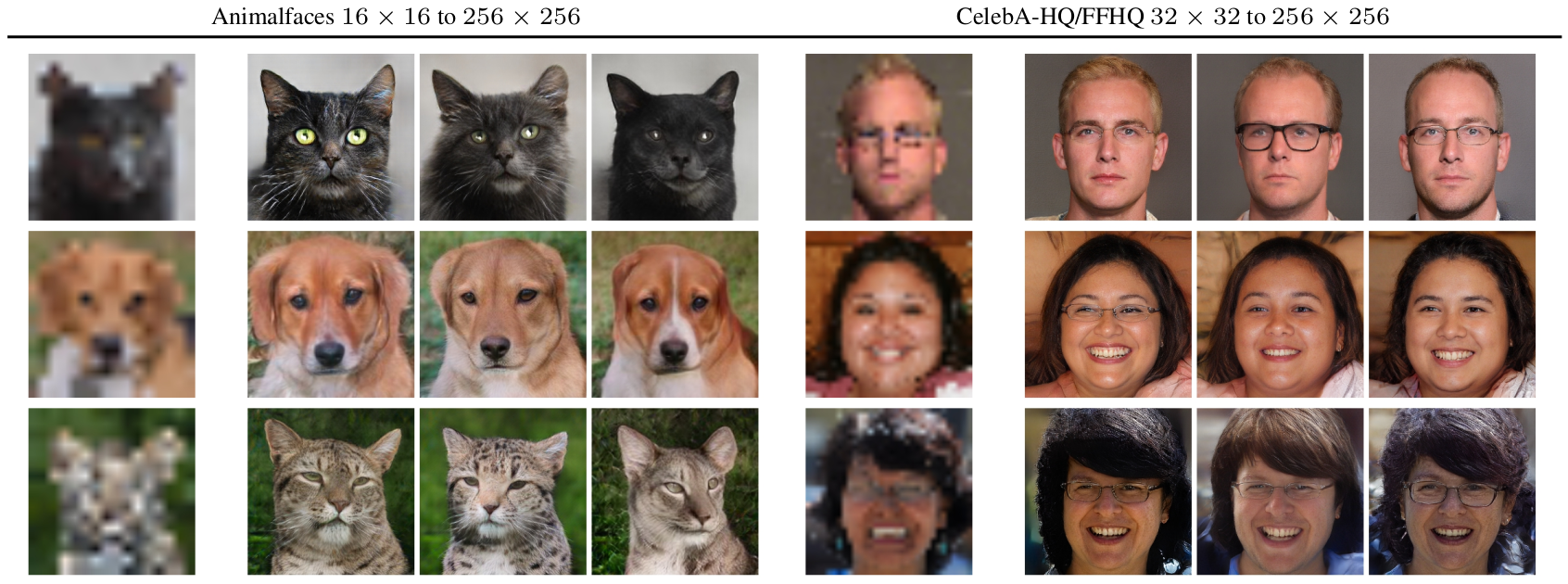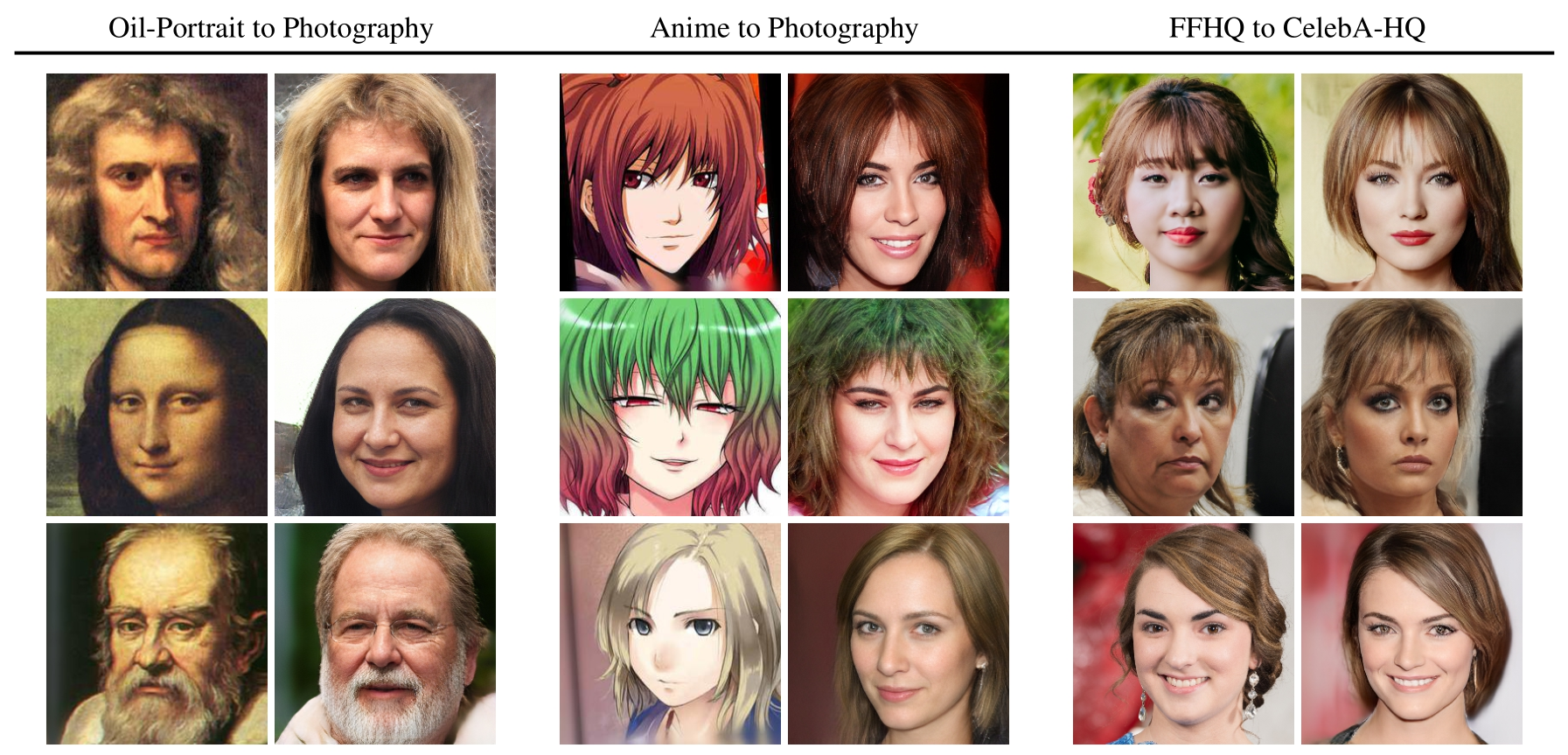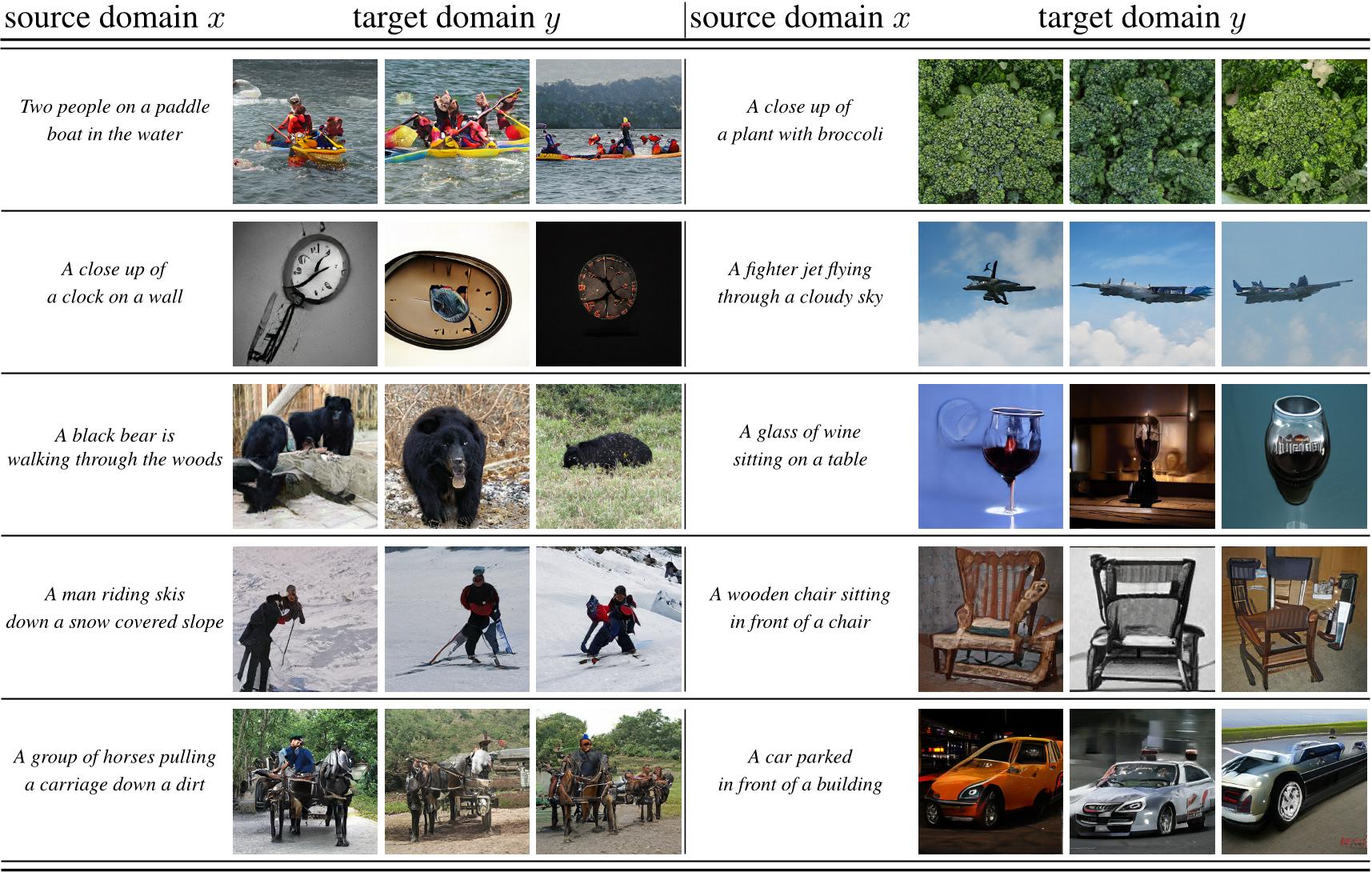CompVis / Net2net
Programming Languages
Projects that are alternatives of or similar to Net2net
Net2Net
Code accompanying the NeurIPS 2020 oral paper
Network-to-Network Translation with Conditional Invertible Neural Networks
Robin Rombach*,
Patrick Esser*,
Björn Ommer
* equal contribution
tl;dr Our approach distills the residual information of one model with respect to another's and thereby enables translation between fixed off-the-shelf expert models such as BERT and BigGAN without having to modify or finetune them.
 arXiv | BibTeX | Project Page
arXiv | BibTeX | Project Page
News Dec 19th, 2020: added SBERT-to-BigGAN, SBERT-to-BigBiGAN and SBERT-to-AE (COCO)
Requirements
A suitable conda environment named net2net can be created
and activated with:
conda env create -f environment.yaml
conda activate net2net
Datasets
-
CelebA: Create a symlink 'data/CelebA' pointing to a folder which contains the following files:
These files can be obtained here.. ├── identity_CelebA.txt ├── img_align_celeba ├── list_attr_celeba.txt └── list_eval_partition.txt -
CelebA-HQ: Create a symlink
data/celebahqpointing to a folder containing the.npyfiles of CelebA-HQ (instructions to obtain them can be found in the PGGAN repository). -
FFHQ: Create a symlink
data/ffhqpointing to theimages1024x1024folder obtained from the FFHQ repository. -
Anime Faces: First download the face images from the Anime Crop dataset and then apply
the preprocessing of FFHQ to those images. We only keep images
where the underlying dlib face recognition model recognizes
a face. Finally, create a symlink
data/animewhich contains the processed anime face images. -
Oil Portraits: Download here.
Unpack the content and place the files in
data/portraits. It consists of 18k oil portraits, which were obtained by running dlib on a subset of the WikiArt dataset dataset, kindly provided by A Style-Aware Content Loss for Real-time HD Style Transfer. -
COCO: Create a symlink
data/cococontaining the images from the 2017 split intrain2017andval2017, and their annotations inannotations. Files can be obtained from the COCO webpage.
ML4Creativity Demo
We include a streamlit demo, which utilizes our approach to demonstrate biases of datasets and their creative applications. More information can be found in our paper A Note on Data Biases in Generative Models from the Machine Learning for Creativity and Design at NeurIPS 2020. Download the models from
- 2020-11-30T23-32-28_celeba_celebahq_ffhq_256
- 2020-12-02T13-58-19_anime_photography_256
- 2020-12-02T16-19-39_portraits_photography_256
and place them into logs. Run the demo with
streamlit run ml4cad.py
Training
Our code uses Pytorch-Lightning and thus natively supports
things like 16-bit precision, multi-GPU training and gradient accumulation. Training details for any model need to be specified in a dedicated .yaml file.
In general, such a config file is structured as follows:
model:
base_learning_rate: 4.5e-6
target: <path/to/lightning/module>
params:
...
data:
target: translation.DataModuleFromConfig
params:
batch_size: ...
num_workers: ...
train:
target: <path/to/train/dataset>
params:
...
validation:
target: <path/to/validation/dataset>
params:
...
Any Pytorch-Lightning model specified under model.target is then trained on the specified data
by running the command:
python translation.py --base <path/to/yaml> -t --gpus 0,
All available Pytorch-Lightning trainer arguments can be added via the command line, e.g. run
python translation.py --base <path/to/yaml> -t --gpus 0,1,2,3 --precision 16 --accumulate_grad_batches 2
to train a model on 4 GPUs using 16-bit precision and a 2-step gradient accumulation. More details are provided in the examples below.
Training a cINN
Training a cINN for network-to-network translation usually utilizes the Lighnting Module net2net.models.flows.flow.Net2NetFlow
and makes a few further assumptions on the configuration file and model interface:
model:
base_learning_rate: 4.5e-6
target: net2net.models.flows.flow.Net2NetFlow
params:
flow_config:
target: <path/to/cinn>
params:
...
cond_stage_config:
target: <path/to/network1>
params:
...
first_stage_config:
target: <path/to/network2>
params:
...
Here, the entries under flow_config specifies the architecture and parameters of the conditional INN;
cond_stage_config specifies the first network whose representation is to be translated into another network
specified by first_stage_config. Our model net2net.models.flows.flow.Net2NetFlow expects that the first
network has a .encode() method which produces the representation of interest, while the second network should
have an encode() and a decode() method, such that both of them applied sequentially produce the networks output. This allows for a modular combination of arbitrary models of interest. For more details, see the examples below.
Training a cINN - Superresolution
 Training details for a cINN to concatenate two autoencoders from different image scales for stochastic
superresolution are specified in
Training details for a cINN to concatenate two autoencoders from different image scales for stochastic
superresolution are specified in configs/translation/faces32-to-256.yaml.
To train a model for translating from 32 x 32 images to 256 x 256 images on GPU 0, run
python translation.py --base configs/translation/faces32-to-faces256.yaml -t --gpus 0,
and specify any additional training commands as described above. Note that this setup requires two pretrained autoencoder models, one on 32 x 32 images and the other on 256 x 256. If you want to train them yourself on a combination of FFHQ and CelebA-HQ, run
python translation.py --base configs/autoencoder/faces32.yaml -t --gpus <n>,
for the 32 x 32 images; and
python translation.py --base configs/autoencoder/faces256.yaml -t --gpus <n>,
for the model on 256 x 256 images. After training, adopt the corresponding model paths in configs/translation/faces32-to-faces256.yaml. Additionally, we provide weights of pretrained autoencoders for both settings:
Weights 32x32; Weights256x256.
To run the training as described above, put them into
logs/2020-10-16T17-11-42_FacesFQ32x32/checkpoints/last.ckptand
logs/2020-09-16T16-23-39_FacesXL256z128/checkpoints/last.ckpt, respectively.
Training a cINN - Unpaired Translation
 All training scenarios for unpaired translation are specified in the configs in
All training scenarios for unpaired translation are specified in the configs in configs/creativity.
We provide code and pretrained autoencoder models for three different translation tasks:
-
Anime ⟷ Photography; see
configs/creativity/anime_photography_256.yaml. Download autoencoder checkpoint (Download Anime+Photography) and place intologs/2020-09-30T21-40-22_AnimeAndFHQ/checkpoints/epoch=000007.ckpt. -
Oil-Portrait ⟷ Photography; see
configs/creativity/portraits_photography_256.yamlDownload autoencoder checkpoint (Download Portrait+Photography) and place intologs/2020-09-29T23-47-10_PortraitsAndFFHQ/checkpoints/epoch=000004.ckpt. -
FFHQ ⟷ CelebA-HQ ⟷ CelebA; see
configs/creativity/celeba_celebahq_ffhq_256.yamlDownload autoencoder checkpoint (Download FFHQ+CelebAHQ+CelebA) and place intologs/2020-09-16T16-23-39_FacesXL256z128/checkpoints/last.ckpt. Note that this is the same autoencoder checkpoint as for the stochastic superresolution experiment.
To train a cINN on one of these unpaired transfer tasks using the first GPU, simply run
python translation.py --base configs/creativity/<task-of-interest>.yaml -t --gpus 0,
where <task-of-interest>.yaml is one of portraits_photography_256.yaml, celeba_celebahq_ffhq_256.yaml
or anime_photography_256.yaml. Providing additional arguments to the pytorch-lightning
trainer object is also possible as described above.
In our framework, unpaired translation between domains is formulated as a
translation between expert 1, a model which can infer the domain a given image
belongs to, and expert 2, a model which can synthesize images of each domain.
In the examples provided, we assume that the domain label comes with the
dataset and provide the net2net.modules.labels.model.Labelator module, which
simply returns a one hot encoding of this label. However, one could also use a
classification model which infers the domain label from the image itself.
For expert 2, our examples use an autoencoder trained jointly on all domains,
which is easily achieved by concatenating datasets together. The provided
net2net.data.base.ConcatDatasetWithIndex concatenates datasets and returns
the corresponding dataset label for each example, which can then be used by the
Labelator class for the translation. The training configurations for the
autoencoders used in the creativity experiments are included in
configs/autoencoder/anime_photography_256.yaml,
configs/autoencoder/celeba_celebahq_ffhq_256.yaml and
configs/autoencoder/portraits_photography_256.yaml.
Unpaired Translation on Custom Datasets
Create pytorch datasets for each
of your domains, create a concatenated dataset with ConcatDatasetWithIndex
(follow the example in net2net.data.faces.CCFQTrain), train an
autoencoder on the concatenated dataset (adjust the data section in
configs/autoencoder/celeba_celebahq_ffhq_256.yaml) and finally train a
net2net translation model between a Labelator and your autoencoder (adjust
the sections data and first_stage_config in
configs/creativity/celeba_celebahq_ffhq_256.yaml). You can then also add your
new model to the available modes in the ml4cad.py demo to visualize the
results.
Training a cINN - Text-to-Image
 We provide code to obtain a text-to-image model by translating between a text
model (SBERT) and an image decoder. To show the
flexibility of our approach, we include code for three different
decoders: BigGAN, as described in the paper,
BigBiGAN,
which is only available as a tensorflow model
and thus nicely shows how our approach can work with black-box experts, and an
autoencoder.
We provide code to obtain a text-to-image model by translating between a text
model (SBERT) and an image decoder. To show the
flexibility of our approach, we include code for three different
decoders: BigGAN, as described in the paper,
BigBiGAN,
which is only available as a tensorflow model
and thus nicely shows how our approach can work with black-box experts, and an
autoencoder.
SBERT-to-BigGAN
Train with
python translation.py --base configs/translation/sbert-to-biggan256.yaml -t --gpus 0,
When running it for the first time, the required models will be downloaded automatically.
SBERT-to-BigBiGAN
Since BigBiGAN is only available on
tensorflow-hub, this example has an
additional dependency on tensorflow. A suitable environment is provided in
env_bigbigan.yaml, and you will need COCO for training. You can then start
training with
python translation.py --base configs/translation/sbert-to-bigbigan.yaml -t --gpus 0,
Note that the BigBiGAN class is just a naive wrapper, which converts pytorch
tensors to numpy arrays, feeds them to the tensorflow graph and again converts
the result to pytorch tensors. It does not require gradients of the expert
model and serves as a good example on how to use black-box experts.
SBERT-to-AE
Similarly to the other examples, you can also train your own autoencoder on COCO with
python translation.py --base configs/autoencoder/coco256.yaml -t --gpus 0,
or download a pre-trained one, and translate to it by running
python translation.py --base configs/translation/sbert-to-ae-coco256.yaml -t --gpus 0,
Shout-outs
Thanks to everyone who makes their code and models available.
- BigGAN code and weights from: LoreGoetschalckx/GANalyze
- Code and weights for the captioning model: https://github.com/sgrvinod/a-PyTorch-Tutorial-to-Image-Captioning
BibTeX
@misc{rombach2020networktonetwork,
title={Network-to-Network Translation with Conditional Invertible Neural Networks},
author={Robin Rombach and Patrick Esser and Björn Ommer},
year={2020},
eprint={2005.13580},
archivePrefix={arXiv},
primaryClass={cs.CV}
}
@misc{esser2020note,
title={A Note on Data Biases in Generative Models},
author={Patrick Esser and Robin Rombach and Björn Ommer},
year={2020},
eprint={2012.02516},
archivePrefix={arXiv},
primaryClass={cs.CV}
}
